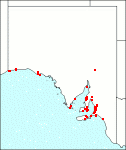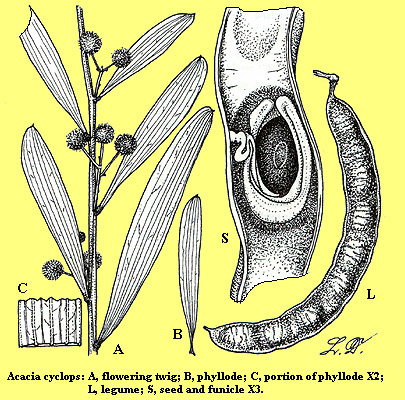Family: Fabaceae
Acacia cyclops

Citation:
G. Don, Gen. Syst. 2:404 (1832).
Derivation: cyclops (Gr.)— round-eyed; refers to the funicle encircling the seed forming an eye-like appearance.
Synonymy: Acacia cyclopis Common name: western coastal wattle
Description:
Dense, bushy, rounded, glabrous, spreading shrubs 2-4 m high, branching at or just above ground level often with foliage almost to the ground, obscuring the stems; branchlets angular and light greenish-brown but almost terete becoming dark brown with age, a conspicuous feature is the old legumes which often persist on the bush after the seeds have been shed.
Phyllodes narrowly oblong to narrowly obovate, 4-9 cm long, 6-12 mm broad, straight or curved, coriaceous, veins longitudinal, 3-5 with the mid-vein often slightly more prominent and a number of less conspicuous reticulate lateral veins, apex obtuse with a small hard lateral mucro; glands basal.
Inflorescences normally shortly racemose with 2-3 heads on a short stout rachis, rarely solitary; flower-heads, globular, yellow, c. 40-flowered; peduncles slender, glabrous, 5-12 mm long; flowers 5-merous.
Legumes narrowly-oblong, 4-10 cm long, 8-12 mm broad, curved finally twisted, coriaceous, marked with a number of transverse splits when mature, usually greyish-brown, margins thickened not constricted. Seeds longitudinal or slightly oblique in legume; funicle thick and a conspicuous, red or yellowish orange colour, encircling the seed in a double fold.
|
|
Distribution:
|
Rather sparsely scattered along the coast, in open scrub from Nullarbor, Eyre Peninsula then eastwards, with a few occurrences on Yorke Peninsula, Northern Lofty and Kangaroo Island regions. In some of these latter localities it is rather doubtful whether the species is native. Soils; mainly calcareous sands, shallow calcareous loam or brown calcareous earths. Rainfall 200-500 mm. Also W.Aust.
S.Aust.: NU, FR, EP, NL, YP, SL, KI.
|
Conservation status:
Lang & Kraehenbuehl (1987) consider this species to be Uncommon to Rare depending on site.
Flowering time: December — March.
|

SA Distribution Map based
on current data relating to
specimens held in the
State Herbarium of South Australia
|
Biology:
No text
Taxonomic notes:
Herbert (1920) attempted to separate A. cyanophylla, A. saligna and A. cyclops. He considered A. cyclops easy to separate and the difficulties due to confusion in the nursery trade. He then attempted to separate A. cyanophylla from A. saligna considering that there were minor differences in the petal midrib and the funicle that could be used. This has not proved successful, see Maslin (1974).
Holmes, Dennill & Moll (1987) studied the effect of a hemipteran feeding on A. cyclops seed. Feeding significantly reduced seed viability and evidence was presented that it may substantially reduce seed density in the soil.
An account of the distribution and dispersal of A. cyclops in Australia may be found in Gill (1985). The distribution stretches from Jurien Bay on the western coast of Western Australia to Kangaroo Island in South Australia. The shrubs are essentially coastal in naturally or artificially disturbed habitats mostly, but not wholly, on calcareous sands.
Reproduction was only by seeds which have a bright red axil encircling the shiny black seed. The pods open in late spring or early summer and the seeds tend to be held on the pod by the aril thus presenting a colourful display of black and red. The aril contains up to 40% oil and is sought by both birds and ants. Silver eyes, honeyeaters, wattle birds, bronzewinged pigeons, currawongs and magpies are known to distribute seeds. Once on the ground ants appear to be the principal agents for seed movement and at least six genera of ants may be active. Predators of seed crops include the Pink Cockatoo and many bugs, weevils and moths.
Acacia species were imported to South Africa as early as 1845 to control sand movement on the Cape Flats, Roux (1961). The names used were Pt. Jackson Wattle a misnomer for A. cyanophylla (now A. saligna) and A. glaucophylla applied to A. cyclops. By 1884 thousands of pounds of seeds were being distributed. The latter soon acquired the Afrikaan name "rooikrans" red wreath, a reference to the red funicle surrounding the seed. It is a serious menace in many parts of the Cape Province where it may form dense, impenetrable stands invading and displacing indigenous flora. However it does produce useful firewood, Ross (1975).
Acacia cyclops is now an important weedy shrub in South Africa and much work on its control has been done there. Holmes (1989) presents an account of the decay rates in buried seed populations of different densities. Loss rates were high and up to 97% of the seeds tested either germinated or rotted by the end of the first year. There was no significant effect of density but seeds have enhanced survival probabilities with increasing time in the soil.
Roux & Warren (1963) considered the vigor of A. cyclops in the Cape Flats and demonstrated that effective nodulation and the ability to fix nitrogen were an element in their success.
Jones, Roux & Warren (1963) using water extracts from roots, pod and leaf of A. cyclops showed that germination inhibitors could delay the development of test species but did not inhibit it. Anti-bacterial effect of the extracts was also demonstrated.
Roux & Middlemiss (1963) discussed the occurrence and distribution of A. cyanophylla (=A. saligna) and A. cyclops in the Cape Flats. These two-species are now abundant. Maps of their distribution show them to be essentially coastal except in the winter rainfall area of the Western Cape where invasion is also inland. The species invade disturbed areas particularly after fire which virtually assures their persistence since the seeds are resistant to high temperatures. Along the NW coast of the Cape further spread may be limited by low rainfall. The altitudinal limit is approximately 330 m for A. cyclops and perhaps slightly less for A. saligna. The colonies become dense and overtop all native plants and bring about complete suppression of all other vegetation.
Jones (1963) showed the seed weights of A. cyclops to be 40-41 mg and that of A. saligna (as cyanophylla) to be 18-21 mg. These were greater than those of 5 native plants from the area and were considered to give the Acacia seedlings an advantage. Best germination was obtained by nicking the seed (scarification) and although putting the seed in boiling water also increased germination, heating for longer than 3 minutes soon reduced success. Likewise treating with sulphuric acid also enhanced germination. Heat treatment was not very effective.
Middlemiss (1963) recorded 21 species of birds eating the seeds of A. cyclops in the Cape Peninsula. The extent to which seeds would be distributed would depend on the ranges of the bird. She considered doves and in particular starlings to be the most effective distributors. In addition to the birds, seeds were also taken by a rat and a baboon. The first dislodges seed to the ground but with the baboon many whole seeds are passed in its faeces and distribution takes place.
Glyphis et al. (1981) studied the dispersal of A. cyclops by birds in the Cape Peninsula. It is a common experience to find colonies of seedlings beneath tall elements or in bush clumps which are used as perches by birds. The seeds contain 23% protein, 6% fat and 40% soluble carbohydrate. However the funicle which is similar in weight to the seed has relatively high fat (44%) and low protein (12%) and soluble carbohydrate (15%). The fat and hence energy content of the A. cyclops funicle is about six times greater than other Acacia species. Significantly more A. cyclops seedlings occurred under clumps of tall shrubs than in surrounding sparser and shorter vegetation which may be 200-500 m distant. Seeds extracted from bird faeces had enhanced germination and they conclude that the species is well adapted to bird dispersal.
The natural insect enemies of A. cyclops and A. saligna in Western Australia have been studied by Van den Berg (1980a, b, c). Larvae of 26 species of Lepidoptera (moths and butterflies) were found on A. cyclops. Those damaging phyllodes were most common but a reduction of 15-28% of total seed production by an unidentified Cosmopterigid was found. Adults or larvae of 35 species of Coleoptera (beetles and weevils) were found on A. cyclops of which 11 species were also found on A. saligna. The reduction of about 20% in seed production was caused by two Melanterius species (Curculionid beetles). Adults and or nymphs of 27 Hemipterous species (cicadas, plant hoppers, plant lice, scale insects and bugs) were found on A. cyclops of which 11 were also found on A. saligna. Those feeding on the sap and twigs were most abundant. This study was done in the hope of finding some biological control of these Acacia in South Africa.
Roux (1965) as a result of growing plants in water cultures provided the following order of increasing salt tolerance A. melanoxylon, A. longifolia, A. cyclops and A. saligna (A. cyanophylla). The sequence bears a direct relation to the altitude to which the species normally grow on the Table Mountain Range, South Africa. A. cyclops and A. saligna could both tolerate up to 4.0 sodium chloride.
A. cyclops is also locally established in Portugal.
Cultivation:
A dense shrub, suitable for low shelter planting in coastal areas. It is able to withstand wind, tolerate salt spray and also assist in soil stabilisation.
Author:
Not yet available
Source:

|

